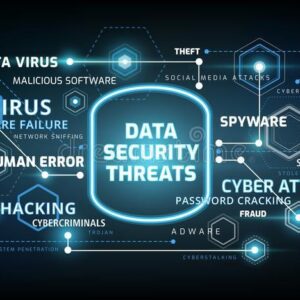As we step further into the digital age, cybersecurity remains one of the most critical fields in technology. With evolving threats and increasingly sophisticated attack methods, organizations are constantly challenged to stay ahead. The cybersecurity landscape is changing rapidly, and in the coming years, new trends are expected to emerge that will define how businesses and individuals protect their data, assets, and privacy.
Here’s a look at some of the most significant emerging trends in cybersecurity for 2025 and beyond:
1. AI and Machine Learning Integration
Artificial Intelligence (AI) and Machine Learning (ML) are already playing a role in cybersecurity, but their importance will continue to grow as we approach 2025. AI-driven solutions are becoming essential in detecting threats more efficiently than traditional methods. These technologies can analyze vast amounts of data, recognize patterns, and identify anomalies in real-time.
For example, AI algorithms can spot unusual network behavior, unauthorized access, and potential data breaches before they escalate. By utilizing AI, cybersecurity teams can act proactively, reducing response time and increasing the chances of mitigating attacks before they cause significant damage.
Additionally, adversaries will use AI to make their attacks more sophisticated, which means cybersecurity systems will need to become even more intelligent and adaptive to stay one step ahead.
2. Zero Trust Architecture (ZTA)
Zero Trust is no longer just a buzzword—it’s an evolving security model. The concept revolves around the idea that no entity, whether inside or outside the organization, should automatically be trusted. Every user and device must be verified continuously before being granted access to systems and data.
Zero Trust will continue to gain momentum in 2025 as businesses seek to protect their networks in the face of increased cyberattacks, especially with remote work becoming permanent in many sectors. By implementing Zero Trust, organizations will require authentication, authorization, and encryption for every action, regardless of whether the user is within the corporate network or outside of it.
This trend will be especially critical as businesses extend their digital footprints with cloud-based solutions and IoT devices, both of which require more stringent access controls.
3. Cloud Security Expansion
As cloud computing continues to rise, securing cloud infrastructure will remain one of the most pressing cybersecurity challenges. By 2025, more organizations will rely on hybrid and multi-cloud environments, leading to a more complex attack surface.
Cybersecurity experts predict that more advanced tools will emerge to protect cloud environments, such as Cloud Security Posture Management (CSPM) tools that help organizations identify misconfigurations and vulnerabilities. Additionally, the integration of AI and automation into cloud security will be vital in handling the scale and dynamic nature of cloud deployments.
Data privacy regulations will also force organizations to rethink their cloud security strategies. With countries around the world enacting stricter data protection laws, securing cloud data storage and transfers will become a top priority for businesses of all sizes.
4. Ransomware and Cyber Extortion Threats
Ransomware has been a persistent threat over the past few years, and it is poised to continue being a major issue in 2025 and beyond. Attackers are becoming increasingly creative, targeting critical infrastructure, municipalities, healthcare systems, and even the education sector.
The emergence of “double extortion” tactics, where attackers steal sensitive data before encrypting it, will likely become more widespread. This gives attackers leverage to demand a ransom not only to decrypt data but also to prevent the release of stolen information. As the stakes rise, organizations will need to implement stronger backup and recovery systems, as well as invest in cybersecurity awareness training to reduce the chances of falling victim to these attacks.
In addition to ransomware, cyber extortion groups will continue to target high-value companies, utilizing sophisticated social engineering techniques to gain access to sensitive information.
5. Quantum Computing and Cryptography
Quantum computing, still in its early stages, has the potential to break traditional encryption methods that rely on mathematical algorithms. This represents an existential threat to the current state of cybersecurity, especially with industries like finance, healthcare, and government heavily reliant on encryption.
By 2025, quantum computers could be powerful enough to undermine the cryptographic protocols that form the backbone of many security systems. As a result, the field of quantum-resistant cryptography will emerge as one of the most critical areas of focus.
Quantum-safe encryption methods will need to be developed and implemented to protect against the anticipated advances in quantum computing. Security experts are already working on “post-quantum” cryptographic algorithms that can withstand quantum decryption methods. This will be an ongoing trend as quantum computing technology becomes more advanced and accessible.
6. Privacy-Enhancing Computation
As data privacy regulations continue to evolve (think GDPR, CCPA, etc.), organizations will look for new ways to protect sensitive data while still enabling analytics and business intelligence. One solution gaining traction is Privacy-Enhancing Computation (PEC), a suite of technologies that allows data to be processed without exposing it.
For example, techniques like homomorphic encryption, federated learning, and secure multi-party computation (SMPC) enable organizations to analyze encrypted data, share insights across multiple parties, and perform computations without ever revealing raw data. This trend will be important as businesses strive to meet compliance requirements while maximizing the value of their data.
By 2025, PEC technologies will become more mainstream, allowing organizations to unlock valuable insights while maintaining privacy.
7. IoT and Operational Technology (OT) Security
With the growing adoption of Internet of Things (IoT) devices and the rise of Operational Technology (OT) systems in critical sectors (such as manufacturing, energy, and transportation), securing these devices will be crucial. Many IoT devices have security vulnerabilities due to inadequate protection and outdated software, and as they proliferate in smart cities, homes, and industries, they present a larger attack surface.
In the coming years, there will be an increased emphasis on securing these devices through better authentication, continuous monitoring, and secure software development practices. Governments and regulatory bodies will likely impose stricter standards for IoT and OT cybersecurity, driving manufacturers to incorporate stronger security features in their products from the outset.
8. Cybersecurity Workforce Expansion and Reskilling
The demand for cybersecurity professionals is already outpacing supply, and this shortage will only become more pronounced in the coming years. As new technologies and attack vectors emerge, companies will need a skilled workforce to combat the growing cyber threat landscape.
To address this challenge, organizations will continue to invest in cybersecurity talent by expanding training programs, offering certifications, and encouraging reskilling initiatives for those in adjacent fields. Moreover, cybersecurity will become a critical part of education curricula, with more academic institutions offering specialized programs in cyber defense, threat hunting, and security analytics.
Conclusion
As we approach 2025, the cybersecurity landscape will undoubtedly be shaped by advancements in technology and an evolving threat environment. AI, Zero Trust, cloud security, ransomware mitigation, quantum computing, and privacy protection will be pivotal areas of focus. By staying ahead of these emerging trends and adapting to new challenges, businesses and individuals can bolster their defenses, reduce vulnerabilities, and protect their digital assets for the future.
Cybersecurity will continue to be a dynamic field, requiring constant vigilance, innovation, and collaboration. It’s clear that the next few years will bring both new challenges and exciting opportunities to safeguard our increasingly interconnected world.














